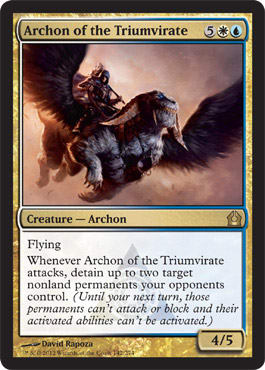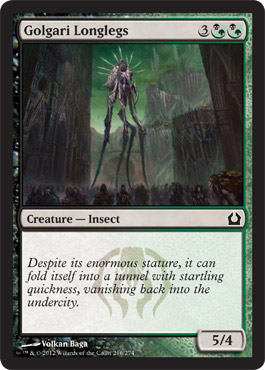This past weekend, I played in a Pro Tour Qualifier that resulted in an interesting experience. I went 0–2, drop, and I wasn’t particularly happy because I felt that I was shafted by my Sealed pool. But I went back and looked at my Sealed pool in detail for the first time in a while, and while it still wasn’t good, I learned something.
I’ve always felt that Draft and Sealed are controlled by variance and card quality to an unacceptable extent. In my experience, what cards you have matters far more often than how you use them. It doesn’t take a lot of skill to cast an Archon of the Triumvirate and turn it sideways, and the fact that games are often dominated by cards like one that genuinely annoys me. The only way to have those cards is through luck (opening them) and having the mana to cast them.
But upon returning from the event, I saw that I habitually place too much emphasis on card quality, and it causes me trouble when I’m confronted with pools that require me to place a stronger emphasis on how I am using my cards and not what cards I am using.
This distinction has always been a difficult one for me (even in Constructed) because my ability to read people and determine what tricks or other cards they are holding is poor. Thus, I habitually rely on having stronger tools and a better understanding of positioning to compensate for my consistent failure to recognize the location of specific tactical interactions.
My problem with embracing strategic plans in Limited is connected to the inherent variance associated with those plans. In Constructed formats, this variance is controlled by redundancy as well as library manipulation such as with Ponder. This strengthens decks’ ability to execute focused strategies such as reanimating Griselbrand as soon as possible.
(Aside: Cube is an interesting study in contrast. I’m a fan of Cube because I feel that such differences in card variance can be removed by a well-designed Cube, bringing the actual skills in Limited formats—play skill and card evaluation—to the forefront.)
While this weekend’s PTQ did little to change my overall opinion of Limited, it afforded me the opportunity to refine my thought process with respect to Sealed. Without further ado, my pool:
"PTQ Sealed Pool"
- White (8)
- 1 Martial Law
- 1 Concordia Pegasus
- 2 Sunspire Griffin
- 1 Trostani's Judgment
- 1 Selesnya Sentry
- 1 Eyes in the Skies
- 1 Rootborn Defenses
- Blue (13)
- 1 Isperia's Skywatch
- 1 Chronic Flooding
- 1 Dispel
- 1 Downsize
- 1 Faerie Impostor
- 1 Blustersquall
- 1 Inspiration
- 1 Cancel
- 1 Paralyzing Grasp
- 2 Tower Drake
- 1 Skyline Predator
- 1 Mizzium Skin
- Black (13)
- 1 Thrill-Kill Assassin
- 1 Deviant Glee
- 1 Dead Reveler
- 2 Catacomb Slug
- 1 Cremate
- 1 Daggerdrome Imp
- 1 Drainpipe Vermin
- 2 Grim Roustabout
- 1 Perilous Shadow
- 1 Tavern Swindler
- 1 Terrus Wurm
- Red (12)
- 1 Tenement Crasher
- 1 Electrickery
- 1 Survey the Wreckage
- 1 Vandalblast
- 1 Viashino Racketeer
- 1 Chaos Imps
- 1 Ash Zealot
- 1 Cobblebrute
- 1 Traitorous Instinct
- 1 Splatter Thug
- 1 Explosive Impact
- 1 Lobber Crew
- Green (8)
- 1 Axebane Stag
- 1 Brushstrider
- 1 Druid's Deliverance
- 1 Deadbridge Goliath
- 1 Aerial Predation
- 1 Wild Beastmaster
- 1 Stonefare Crocodile
- 1 Centaur's Herald
- Artifact and Lands (7)
- 1 Codex Shredder
- 1 Civic Saber
- 2 Golgari Guildgate
- 2 Azorius Guildgate
- 1 Izzet Guildgate
- Rakdos (5)
- 1 Rakdos Shred-Freak
- 1 Rakdos Ragemutt
- 2 Skull Rend
- 1 Rakdos Charm
- Izzet (4)
- 2 Goblin Electromancer
- 1 Chemister's Trick
- 1 Teleportal
- Azorius (1)
- 1 New Prahv Guildmage
- Selesnya (8)
- 1 Sundering Growth
- 1 Growing Ranks
- 1 Risen Sanctuary
- 1 Heroes' Reunion
- 1 Common Bond
- 2 Centaur Healer
- 1 Call of the Conclave
- Golgari (5)
- 1 Grisly Salvage
- 2 Golgari Charm
- 2 Golgari Longlegs
My general approach to Limited—but more specifically to Sealed, has always been to maximize card quality—taking into consideration what my mana will support. Put the best cards you can cast in your deck, and the rest will take care of itself.
This approach works the best when the pool overall has strong spells and/or bombs. Thus, I spent a significant amount of time at the table trying to assess Azorius, Izzet, and American as options. The primary motivating factors were the Martial Law, Blustersquall, and Teleportal.
What I eventually realized was that none of the decks gave me substantially more than the green core of two Centaur Healer, two Golgari Longlegs, one Deadbridge Goliath, and one Common Bond. I knew that my options were a Selesnya or Golgari base, but I didn’t have time to fully vet both options. Thus, I stretched my mana a bit too far. I knew I was in trouble when I went to build my mana base at the last minute and realized it wouldn’t support Martial Law, which I was then forced to cut. At that point, I knew it would be worth going back over this pool to see exactly what happened.
The correct version of the green-based midrange deck is probably something like this; what I actually played was a worse version with no red cards, more black cards, and fewer white cards (I dislike Sunspire Griffin in three-color midrangey builds):
"Green-Based Midrange Sealed"
- Creatures (13)
- 1 Centaur's Herald
- 1 Concordia Pegasus
- 1 Deadbridge Goliath
- 1 Golgari Longlegs
- 1 Risen Sanctuary
- 1 Selesnya Sentry
- 1 Stonefare Crocodile
- 1 Tenement Crasher
- 1 Wild Beastmaster
- 2 Centaur Healer
- 2 Sunspire Griffin
- Spells (10)
- 1 Aerial Predation
- 1 Common Bond
- 1 Explosive Impact
- 1 Eyes in the Skies
- 1 Rootborn Defenses
- 1 Trostani's Judgment
- 1 Call of the Conclave
- 1 Traitorous Instinct
- 1 Martial Law
- 1 Civic Saber
- Lands (17)
- 3 Mountain
- 5 Forest
- 7 Plains
- 2 Golgari Guildgate
Even given that, I’m not a fan of this deck at all because it isn’t good at anything. It doesn’t have huge weaknesses, but it has no strengths. So, why didn’t my approach work?
- The actual approach is more flawed than I would like to admit, but it’s also far more true than I would prefer because in Sealed, you need strengths to exploit tactically.
- The mana I have doesn’t really support a three-color green-based deck that well since I really want to be Naya.
The obvious counter-approach of building based on consistency of execution is one that I’ve always been aware of but never embraced at all. In building my approach to Sealed off what I knew for Constructed, I’d failed to deconstruct my failures and understand when this approach works and when it doesn’t.
The play-good-cards-and-cast-them approach would seem to work as long as you have high-quality cards. In reality, it works best in pools with high spell—as opposed to creature—quality. This seems counterintuitive, but it makes sense when you consider the impact powerful spells have on the game. Rationing these and playing them at the right opportunity can easily turn the game quickly, making your slightly weaker creature suite largely irrelevant. This is why Blustersquall is a better card to build around than Deadbridge Goliath.
This pool in particular showcases that, as the spell suite of any given deck has a weakness in either quality or quantity. In addition, Return to Ravnica stresses the importance of having a plan due to the way the guild mechanics and flavors tend to play out. Here’s why:
Unleash out of Rakdos allows a player to be extremely aggressive with efficiently costed creatures, but not in the overpowered way Zendikar created. Scavenge out of Golgari provides an excellent method for grinding out long games and winning with leftover seemingly bad creatures. Detain out of Azorius is an excellent way of exploiting tempo and game flow. Populate out of Selesnya achieves much the same purpose as scavenge, but from a different angle. Last but not least, Izzet often allows the player to take advantage of strong overload spells such as Blustersquall, Cyclonic Rift, Chemister's Trick, and Teleportal to set up devastating counterattacks.
What I should have played was this:
"Rakdos Overload"
- Creatures (17)
- 1 Ash Zealot
- 1 Chaos Imps
- 1 Cobblebrute
- 1 Daggerdrome Imp
- 1 Dead Reveler
- 1 Lobber Crew
- 1 Rakdos Ragemutt
- 1 Rakdos Shred-Freak
- 1 Splatter Thug
- 1 Tavern Swindler
- 1 Tenement Crasher
- 1 Thrill-Kill Assassin
- 1 Viashino Racketeer
- 2 Golgari Longlegs
- 2 Grim Roustabout
- Spells (6)
- 1 Blustersquall
- 1 Chemister's Trick
- 1 Explosive Impact
- 1 Teleportal
- 1 Traitorous Instinct
- 1 Deviant Glee
- Lands (17)
- 2 Island
- 7 Mountain
- 7 Swamp
- 1 Izzet Guildgate
While this deck isn’t the best aggro deck, it at least has a plan. A solid creature base combined with the blue cards and fatties to push through the last few points is workable. Perhaps splashing all three blue cards is greedy, but it’s definitely stronger than whatever I ended up with, and I feel it’s stronger than the midrange deck. Here are a few reasons why:
- Sunspire Griffin is at its best when it’s attacking backed by detain or other tempo control. It’s not a horribly good defensive creature because there are a lot of 3/3 flyers that will shut it down quickly, and it doesn’t block well against the stronger aggressive creatures such as Splatter Thug and Gore-House Chainwalker.
- The deck overall is vulnerable to flyers. There is no good Spider, and Griffin is easily overpowered by 3-power flyers.
- The midrange deck isn’t fast enough or beefy enough to consistently overpower detain-plus-flyers out of Azorius. The Rakdos deck, on the other hand, is fast enough and has the blue spells as a backup plan.
- The midrange deck will have trouble against populate as well, as the air force isn’t strong enough to punish someone whose plan is simply to gum up the ground. Once again, the Rakdos deck has the blue spells.
- Against Izzet, the midrange deck is going to be extremely vulnerable to Blustersquall, Chemister's Trick, and Teleportal because of the prevalence of 3-power dudes against 4-toughness blockers (Frostburn Weird, Voidwielder, Lobber Crew, etc.) as well as the overall vulnerability to flyers.
The Rakdos deck has its vulnerabilities, too (mostly in a complete inability to combat flyers and 4-toughness blockers), but the addition of Chemister's Trick, Blustersquall, and Teleportal combined with the potential raw speed of the deck gives it a stronger ability to overcome those weaknesses.
My general approach to Limited is not completely erroneous; however, my understanding of it was incomplete. On Saturday, I learned that in middling pools, a plan can trump card quality. I saw again how much a sketchy mana base can hurt you, especially in Limited, where it is often crucial for your creatures to hit on time. So, I formalized something I always knew but never internalized until recently:
It’s okay to durdle, but only if the mana works. If it doesn’t, your deck needs to have a plan.
It’s okay to make mistakes . . . as long as you learn from them.
Chingsung Chang
Conelead most everywhere and on MTGO
Khan32k5 at gmail dot com





























